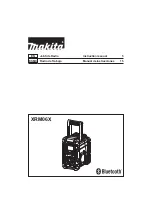
SATELLINE-3AS
User Guide, Version 2.3
34
buffered data has been transmitted. When the serial interface speed is the same or slower than
the speed of the radio interface, the internal transmit buffer memory cannot overflow. However,
when the serial interface speed exceeds the speed of the radio interface, data will eventually fill
the transmit buffer memory. In this instance, it will take a moment after the terminal device has
stopped transmission of data for the radio modem to empty the buffer and before the transmitter
switches off. The maximum size of the transmit buffer memory is one kilobyte (1 kB). If the
terminal device does not follow the status of the CTS-line and transmits too much data to the
radio modem, the buffer will be emptied and the transmission is restarted.
In the receive mode, the buffer works principally in the above described way thus evening out
differences in data transfer speeds. If the terminal device transmits data to a radio modem in
receive mode, the data will go into the transmit buffer memory. Transmission will start
immediately when the radio channel is available.
5.3.2 Optional start delay in transmit mode
The radio modem can be configured to delay the beginning of a radio transmission by
1...65000 ms. This function can be used to prevent packet contention in a system, where all
substations would otherwise answer a poll of a base-station simultaneously. During this delay
data sent to the radio modem is buffered. Although the priority setting is "RX" (see chapter 3.3),
radio modem is prevented to change over to receiving mode during the period of the TX delay.
If this function is not needed, the delay time should be set to 0 ms.
5.4 Tests
The radio modem can be switched to the
Test Mode
, where it will send a test packet on the
radio channel. The test packet is a normal data transmission, which can be used, for example,
when directing antennas during system installation.
When the test packet transmission has been switched on and saved by using the
Programming
Mode
, the transmitting radio modem needs only a power supply and an antenna.
If the channel spacing of the radio modems is 25 kHz, it is recommended to use 38400 bps as
a serial data speed of the receiving radio modem. In the case of 12.5 kHz channel spacing the
data speed of 19200 bps is recommended.
There are two
Test Modes:
Short data block test
In this test mode the radio modem sends a short test string which is preceded by a consecutive
number and it ends to the line feed character. The short data block is repeated continuously
after 1 s break.
















































